Published in revised form in the Proceedings of the IMC'93
Puimichel, France, 23-26 September 1993
An overview is given of observations of the Perseids 1993 in the Provence by members of the Dutch Meteor Society (DMS). We present preliminary results of visual and photographic observations. A likely observation of the Perseid meteoroid cloud in space is discussed.
In 1992, a very successful 'crash'-campaign was organised by members of the Dutch Meteor Society (DMS) to a region near Basel/Mulhouse in order to observe a possible Perseid outburst [1]. Indeed, observers Marco Langbroek, Peter Jenniskens, Carl Johannink, Romke Schievink and Casper ter Kuile did observe the last 20 minutes of an outburst, albeit in deep twilight. The excitement of the event lead us to decide to organise a more extended expedition in August 1993 [2]. In order to escape the usually unpredictable weather conditions in the Netherlands, a multistation network was set up in the Provence in the South of France, the nearest place with good perspectives of clear weather.
The aim of our expedition was to obtain a good activity profile from visual- and radio observations and high precision orbital elements of multistation photographed meteors associated with the outburst. Some doubtful expectations in the press were raised that meteor rates might be well in access of 10,000 meteors/hour, while rates might also not exceed the annual activity. Obviously, we had to prepare for the worst case scenario.
This article will summarise the preparations and give an account of the events during the summer of 1993 [3], [4]. Some preliminary results on the activity curve will be presented. As a special topic we present a detailed description of the Perseid meteoroid cloud which has actually been observed by two independent observing groups located at great distance from each other. Results from the first successful multistation photography of meteors associated with the meteor outburst awaits further reduction of the data.
A series of newsletters informed our members of progress in the organisation [2]. On saturday June 12, DMS organised a preparatory meeting at Harderwijk, the Netherlands, which was attended by 25 meteor observers. Special guests were the Belgium VVS meteor section representative Peter Aneca and the IMO representative Paul Roggemans. We evaluated the logistic problems associated with an expedition, the meteorological aspects of the chosen site, and the necessary changes to the observing techniques in case of high meteor rates.
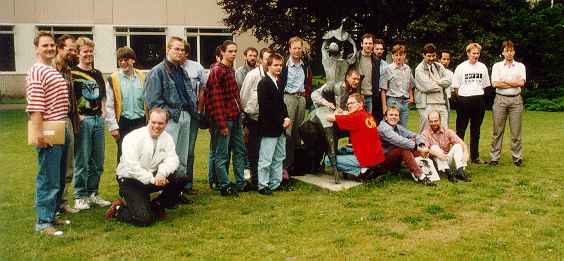
Most visual observers were going to work with memorecorders, which are often equipped with 'time-index recording'. In the quite part of the night, of each meteor we recorded the brightness, classification, DCV (distance from centre of vision), angular velocity and sky location. As activity rose, information was restricted to brightness and if possible DCV, and a note on classification in case the meteor was of a non-Perseid.
One of us, Marco Langbroek, who preferred the use pencil and paper for recording because it is a more reliable means, tried a different method, with the aim of establishing differences between this method and orthodox observing methods. During the period of high activity, and by using his Casio-watch equipped with an audio-signal countdown mode, he conducted pure five minute counts without recording any information but absolute numbers per five minutes and of course periodical sky limiting magnitude estimates. Of course, this means no, information on the magnitude distribution is recorded (no info on r-values). The method proved to give similar ZHR-values than those of other observers.
In order to adopt our photographic techniques for high meteor rates, new equipment was built that allowed for short exposure times and a minimum of dead-time between exposures [5]. Short exposure times greatly ease the correct identification of meteors on negatives. An exposure time of 10 minutes was decided to be a good compromise between available film length and our wish to have as short an exposure time as possible. This demands a fully automatically operated camera battery. The way of approach was the use of Canon AV-1 camera's which are equipped with winders. These winders are controlled by a Canon T-70 with a command back 70. The command back is programmed with a timing accuracy of 1 second. In case of very high rates, reprogramming of the exposure times is possible. The accuracy of orbital elements of Perseids depends highly on the accuracy of time measurements and on the frequency accuracy of the rotating shutters. Precise timing is acquired by means of a DCF time-signal from Frankfurt. Much effort was conducted in constructing high accuracy neatly balanced quartscontrolled rotating shutters. Precise timing and high quality rotating shutters enabled us to achieve an accuracy of 0.05 km/s or even better in meteoroid speed determination.
Two new automatic camera batteries were built by Koen Miskotte and Casper ter Kuile for station Rognes (see later). Jaap van 't Leven constructed a similar system for Tourves and Romke Schievink and Jerôme de Jong van Lier constructed a system for Lardiers. Besides that, Robert Haas completed an automated 6*6 All-Sky camera for Rognes. Klaas Jobse prepared video image intensifier (IPCS) systems that were set up in Puimichel, Lardiers and Tourves.

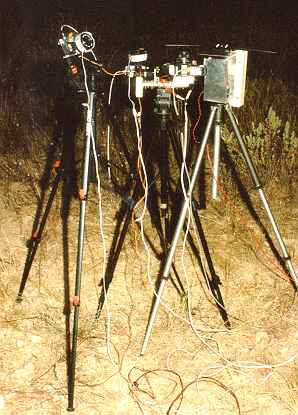
On August 10, 1993, a second meeting was organised by the IMO at Puimichel in the heart of the Provence. An important topic to be discussed during this meeting was the weather prediction provided by Jacob Kuiper. The weatherforecast pointed out that observers had no need to transfer to another location. To illustrate the fulfilment of this forecast we show the weather and cloud-situation at the early morning of August 12 on the satellite picture of southwestern Europe. On this picture (made by Meteosat-4 weathersatellite in the "visible channel at 06.30 UTC) we see an almost cloudless southern France. More to the north some stratocumulus cloud-sheets cover parts of France and Germany. To the Benelux area we see the more thick cloudpattern of the coldfront, giving no way to meteor observations. Southwest of Barcelona we see some remnants of thunderstorm activity. Over Northern Italy a bright fog and hazy area is visible over the basin of the river Po.
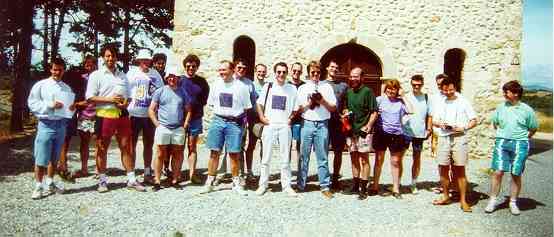
 |
Late in 1992, members of DMS that wanted to participate in the project formed four observing groups. Each group hired a house from the "France Gîte" organisation. These gîtes were chosen to be located about 50 to 70 kilometres apart in order to have optimum geometrical conditions for multistation photography and video observations. The location of the stations is shown in fig. 5.
Marc de Lignie, Klaas Jobse and Michiel van Vliet settled near the town of Puimichel. In Puimichel, both visual-, photographic- and video-observations were carried out. A second group settled in a house between Tourves and Brignoles. The members include: Jaap van 't Leven, Peter van der Heiden, Frank Kooiman and Cor Meulmeester. The observers at Tourves observed visually, photographic, by video and by using radio-equipment. Members of the Werkgroep voor Sterrenkunde of Denekamp settled in Lardiers. Among them: Carl Johannink, Andre Kluitenberg, Romke Schievink, Jerôme de Jong van Lier and Ralf Mulder. French observers at Lardiers include: Evelyne Blomme, Steffan and Liddy. The Lardiers team observed visually, photographically and they used a videocamera.
In Rognes DMS-members Marco Langbroek, Koen Miskotte, Robert Haas and Casper ter Kuile found their observing home. Rognes proved a perfect location near Aix-en-Provence. The members of team Rognes observed visually using time-index recorders, with the exception of Marco Langbroek who used a five minute count system. In total 24 fully automated camera's were used for photographic observations.
Several other groups of meteor observers were present in the Provence during the Perseid campaign.
In Puimichel was also a post manned by members of IMO, namely Paul Roggemans, Peter Brown, Martin Beech and Yasuo Yabu. In addition 35 young observers of the Dutch Astronomical Association were present. Puimichel served as an organizational centre, where observers could receive the latest weather information provided by meteorologist Jacob Kuiper from the Royal Dutch Meteorological Institute (KNMI).
Near Blieux (Castellane) a group of the Belgian VVS, lead by Peter Aneca, settled [6]. Some 30 observers of the International Astronomical Youth Camp observed the Perseids from near Coucouron (Ardeche). Among them was Dutch observer Erwin van Ballegoy.
The well-known observer Joe Rao, from the Unites States of America, found an observing place on a cruise-ship in the Mediterranean sea [7].
Two Dutch observing groups from the Meteor Section (Werkgroep Meteoren) of the Dutch Astronomical Association settled in Salernes and Cabasse, about 18 km apart, including Felix Bettonvil, Urjan Poerink, Ben Apeldoorn, Niek de Kort, Siem van Leverink, Serge ter Hall and others [8].
Many Dutch observers stayed in the Netherlands and attempted to observe the Perseids from there. Bad weather conditions in the Netherlands motivated Jacob Kuiper to travel to the Vogezen Mountains, to the Pointe d'Honneck near Colmar in Northern France. He was joined by a group of observers, including Michiel Severin, Edward Hamers, Mark Neits and Jan Tromp [9].
In addition, a small multistation project was set up by Peter Jenniskens and Mike Wilson in Los Banos and Livermore in California, USA. Although these sites do not allow multistation work with the Provence, they provided useful information on activity and appearance of the outburst.
 |
S = Salernes; C = Cabasse; T = Tourves
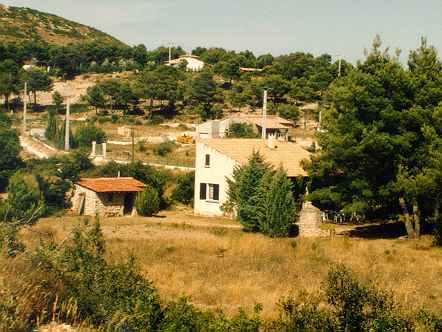

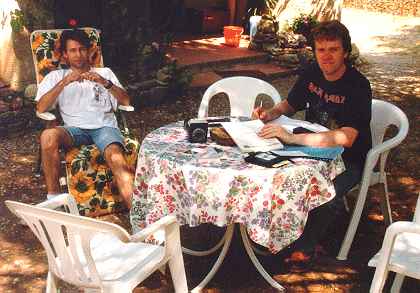
The 'Mother of all Nights' has been really exciting! This is the night we had been waiting for so many months. Many hundreds of hours of very hard labour has been spend on just 7 extraordinary observing hours. Fortunately, it was a fine clear night with very good conditions, slightly affected by moonlight late in the night. With the unexpected early outburst of 1992 in mind, the sky was monitored from the moment of sunset on August 11.
The first set of bright Perseids appeared around 22:30 UT. Everybody thought this was the beginning of the so hoped for Perseid outburst. But rates declined again and at 00:45 UT the observers at Rognes were in despair about what's going on above. To our surprise, and satisfaction, the hourly rate suddenly started to rise after 01:15 UT. Many bright meteors were falling down at every side of the sky. The Perseid show was very impressive! Maximal hourly rates were reached at about 03:00 UT shortly before twilight started interfering.
Visual observations were conducted with sky limiting magnitudes reaching +6.9 in the early part of the night, slowing down to +6.3 after moonrise. From the start of serious observations around 19:45 UT until 22:30 UT, Perseid activity was as normal as can be for this solar longitude, with a ZHR around 60 and normal r-value of 2.5. After 22:30 UT, the r-value suddenly drops to about 1.9, and activity rises to a peak of about ZHR=140 around 00:15 UT. This first phase of enhanced activity is followed by a quick decline in activity to almost normal ZHR-values of 70 around 00:45 UT. Most notably, also the observed r-value rises back to almost normal during this period (2.3). After this decline, leaving the observers quite disappointed, activity dramatically begins to rise after 01:15 UT. The r-value again drops to a value fluctuating around 1.7-2.1. Around 02:45 UT the activity reaches ZHR-values of about 300. After 02:45 UT corrected rates become uncertain, because twilight interfered observations [10].
Around 03:15 UT, most observers observed absolute meteor rates of 25 Perseids per five minute period. Some individual observers with high perception coefficients even noted higher rates (Robert Haas for example noted rates up to 35 per five minutes). Meteors were 'clustered' in groups, a phenomena reported before with regard to the Perseids and typical of Poisson statistics. Also the high variability of rates in successive five minute counts is a feature of a statistical Poisson distribution.
The observations in the Provence were ended around 03:40 UT. In Los Banos (USA) the meteor rates were found to be back to normal around 08:00 UT, suggesting a peak in activity not later than about 03:15 UT if the activity profile was symmetric.
Fig. 7 shows a graph of visually recorded meteors of magnitude 0 and brighter. Some characteristics of these bright meteors were recorded on tape which are needed for the calculation of the orbital elements. We recorded time [UT], location, magnitude and, if essential, trails and colours. The graph is calculated by means of a 1 hour moving average with increments of 1 minute. Please do not forget this graph only shows meteors of about magnitude 0 and brighter! The detailed structure in this graph is not really observed but caused by the mathematical averaging method. Interestingly this figure does not indicate a peak around 22:30 UT neither does it show a clear dip somewhere around 00:45 UT. Marco Langbroek suggests the visually observed decrease in hourly rates around 00:45 UT could have been in a decline in the rate of meteors between magnitude 0 and +2. Such a scenario would explain the different photo-visual results and still account for the observed r-value differences. Evaluation of the visual results must confirm or reject this hypothesis.
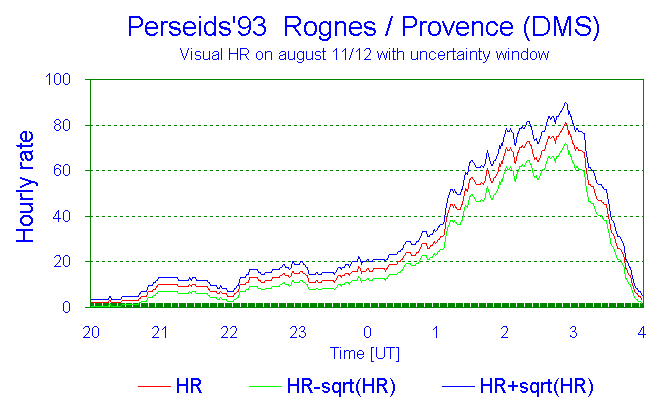
All photographic equipment has operated perfectly. First results show 300 meteors have been photographed in Rognes, of which about 200 in the night 11/12 August 1993. The largest part of these meteors are photographed between 01:30 and 03:30 UT. The total number of multistation photographed meteors is not yet known, but we expect it to be near 200, most of them recorded from three or even four stations. The negatives show 1, 2 or 3 meteors between 01:30 and 03:30 UT which are easy to match with the visible observations. To be sure the meteor on the negative is the same one as observed by the visual observers the accuracy of the location on the sky given by the observer is of high importance. This is the reason why the photographic observer depends heavily on very well trained visual observers!
The graph of fig. 8. shows the number of photographed meteors in 10-minute intervals. Please be aware that this graph shows the total number of photographed meteors including sporadics, Cygnids and others. Note the "peak" around 22:30 UT and the "dip" around 00:30 UT which both confirms the visual observations. On the contrary these features are not present on fig. 7.

Similar successful were the video observations. A bright kappa-Cygnid fireball was captured by Romke Schievink at Lardiers (August 11/12, 00:34:53 UT) and photographically recorded by other stations. During the night 11/12 some confusion as to viewing direction caused many meteors not be filmed multistation. The problem was corrected on 12/13 and many multistation results of annual Perseids were obtained.
Fig. 9. Some photo's of Perseids
Fig. 10. Some photo's of Perseids
A highly interesting observation was obtained from the Provence and the Vogezen Mountains. Two observing teams at totally different locations observed a diffuse cloud before the peak of the outburst. The visibility of this dust cloud is caused by solar light scattered by the dust in the trail of P/Swift-Tuttle. We assume this observation could be of high importance to the scientific world. This is why we describe this observed phenomenon as detailed as possible and spend much effort to show we can exclude every possible source in the earth atmosphere.
US observer Joe Rao was the first to point the attention of the observers to the possibility of visually observing the Perseid meteoroid dustcloud in space [11], [12]. Michiel van Vliet made some computations to find out weather the dustcloud could become visible to the naked eye [2]. His conclusions were quite pessimistic. However, his article and the one of Joe Rao made observers aware that we should be prepared that something like a cloud could be visible during this night. Rao had calculated the position of the cloud to be 10° to the south of Algol. At the time of observation we were not aware that D. Steel proved the calculated position by Rao to be wrong [13]. The predicted location by the IAU (D.I. Steel) was at the true Radiant which is near Polaris: RA,DEC (2000.0) = 33°5, +84°7. D. Kessler and H. Zook recommended to monitor the arc between the true and apparent radiant. They also remark that the glow of a dustcloud which would collide with the earth will become visible at the apparent radiant! [13].
At Rognes, around 00:39 UT observer Robert Haas was the first to draw attention of the other observers to some kind of cloud near Algol. Without any doubt all of us at Rognes clearly could see something resembling a streak of cirrus cloud, but surely it was not cirrus! The position at the sky was roughly from RA,DEC = 64°, +43° to 40°, +36° and centred at 52°, +40° (Fig. 11). Please note that these points indicate the extreme edges of the cloud. Probably a more certain dimension would be 2 by 5 degrees. This position was recorded by Marco Langbroek around 00:45 UT and confirmed by all observers [2].
The appearance of the cloud was like a silvery glow resembling noctilucent clouds or weak aurora. The cloud remained stationary, unlike real cirrus we got later that night, with respect to the starry background. Stars were visible through the cloud. During the observation the cloud broadened and became fainter. The magnitude at first observation was about +4.5 weakening to +5.5 and vanishing. The intensity of the cloud was approximately equal to the intensity of the Milky Way in Perseus. The total duration of observation at Rognes has been some 10-15 minutes from 00:39 UT onwards. Please note the dustcloud probably has been visible some minutes before the first sighting by Robert Haas! Note that hourly rates began to rise very rapidly about half an hour after the cloud 'disappeared' around 00:50 UT.
Most important of all we have a completely independent observation from a location 500 kilometres North of Rognes. This observation is made by Jacob Kuiper at the Vogezen Mountains near Colmar, Northern France [9]. As a meteorologist, Jacob has much experience with cloud types and he is quite certain that the observed phenomenon could not be a cirrus cloud! Jacob agrees fully with the appearance of the cloud described above. Very important is the confirmation by Jacob of the location! Jacob too observed the cloud due East of Algol. Because of the lack of obvious parallax, this evidently means we observed a phenomenon outside the Earths atmosphere! We are quite certain to have observed the meteoroid dustcloud in space.
To be sure that the observers in Rognes and in the vicinity of Colmar have seen an extra-terrestrial phenomenon instead of a terrestrial we have examined all the other "cloud-composition" solutions.
=The first possibility: Cirrus clouds, high in the atmosphere of the earth.
In Colmar Jacob Kuiper saw during more than 1/4 to 1/2 an hour that the glow didn't move with reference to the background of the stars. In the centre of France at a height of 7 tot 10 kilometres above the ground the westerly wind was blowing with a speed of 60 - 100 km/hour at that moment. A cirruscloud should move in half an hour quite a distance in the sky. Later in the night some cirrus has been seen and indeed it moved along the sky quite fast. Also the stars were visible through the glow with their original brightness. Even a thin cirruscloud is able to capture the light of weak stars. An experienced observer is able to see the difference with the situation of that moment.
=The second possibility:Noctilucent clouds, at a height of around 80 km above the surface of the earth. This type of "cloud" consists of meteoritic dust, covered with a very thin layer of water-ice. In the months June, July and August sometimes men can observe these clouds 1 or 1,5 hours after sunset or before sunrise at northern Latitudes of more than 50 degrees. The observation of the "Perseid cloud" took place outside the noctilucent cloud visibility window and at geographic positions with a latitude less than 50 degrees North.
=The third possibility: Aurora Borealis or polar light at heights of 100 kilometres above the earth or more.
Mostly the aurora-phenomena are seen at high northern or southern latitudes. Sometimes when the activity of the sun is very high the area where aurora can be seen is stretching to more southerly latitudes. At first if the Perseid phenomenon should have been aurora, then there should have been the parallax problem. Watched at the same time from the Provence and from the Vogezen this aurora should have had a different position in the night sky. A glow, 100 km above the earth cannot be seen in the same northerly direction and position when the observation places are 500 km separated from each other.
To be sure that it is not aurora, Jacob Kuiper has asked information about the activity of the ionosphere in that particular night. The head of the Geophysics Department of the Royal Meteorological Institute in Belgium could provide some data of the solar-activity at that time. These data show no extreme activity of the sun and no big disruption of the geo-magnetic field of the earth. To create aurora above central and southern France this last condition would have been essential.
Every other possibility, for instance reflection of big town lights on high clouds, is not in case. Also because of the parallax problem which immediately occurs. The distance of 500 kilometres is a big advantage to oppose the other (hypothetical) answers.
We would like to point out that the observed location of the dust cloud is definitely NOT the same as the (wrong) position indicated by Rao. People may have doubts about our observations, because 'our' cloud appeared at another location than it theoretically should have been according to IAUC 5840. We would like to point out, however, that the position stated in IAUC 5840 is given to be the case for 'a strong concentration of material exactly such that it will collide with the Earth' (emphasis added). But, the fact that there did NOT occur an intensive meteor storm, strongly suggests that the concentration was NOT on an Earth-colliding course! That this would happen, had already been predicted by Jenniskens well before the 1993 outburst [14], [15]. Also, 'our' cloud, within the accuracy of the observation, DID occur on the arc joining true radiant, apparent radiant and anti-radiant.
Interestingly, a possible photograph of the cloud was presented by Ben Apeldoorn (Meteor Section of the Dutch Astronomical Association) after we brought our observation to his attention [8]. However, his photographs were made two to three hours after our sighting and the linear features on it are very distinctive from the phenomenon we observed. In our opinion the linear features on the photo's made by Ben Apeldoorn might be caused by internal reflections of moonlight in the complex lens system of his fish eye lens. The only feature which seems not to be caused by reflected moonlight, bears a close resemblance to the isolated cirrus clouds we photographed at Rognes around the same time, and can be seen to be evidently moving across the sky on the series of photographs.
The observers at Rognes and Jacob Kuiper near Colmar appreciate any observation which could prove our observations. Especially (professional) photographs and CCD registrations, if they exist, are much welcomed! We strongly call for observers to monitor this sky-area for the phenomenon during the 1994 appearance!
 |
It is for sure we have seen a remarkable display of the Perseids in 1993. We did not observe a meteorstorm but rates up to ZHR=300 and may be even higher are really impressive! Normal activity lasted from twilight until about 22:00 UT. An increase was observed around 22:30 UT. A dip in rates occurred around 00:45 UT. Than after 01:15 UT a sharp increase in activity. The zenithal hourly rate is troublesome from 02:45 onward. This observed activity profile is in good agreement with other reports from Europe [16], [17], [18].
We obtained about 200 multistation meteors photographically, which awaits further reduction. A large number of meteors were filmed from two stations by video image intensifiers systems.
Most remarkable observation surely is our observation of the Perseid meteoroid cloud in space. This phenomenon has been observed independently by the observers at Rognes and by meteorologist Jacob Kuiper near Colmar. It should be very interesting to learn why the Perseid cloud has been visible at the observed position. Because the Perseid outburst has not been very spectacular, we must conclude that the Earth did not collide with the Perseid dustcloud. Did we actually experience a near miss as predicted by Jenniskens [14], [15]? A number of questions still remain at this moment: At what distance did the Earth and the meteoroid cloud pass each other? What is the measurement of the dustcloud? Did we observe only a dense part of a filament or the main stream of the Perseid dustcloud? Probably the outburst which happened about 3 hours later may be caused by the passage of the earth through a dust filament which is not the same as the dustcloud we observed. Hopefully professional astronomers can cast some light on this complicated but very interesting matter!
(note page...: we believe there is some confusion about our observations of the 1992 outburst from Switzerland [1]. Kidger [19] states as if our observations of the 1992 outburst were done from The Netherlands. However, we were on location in the Swiss-French border area, near Basel. Also, we suspect that the correspondence by Brian Marsden stated by Kidger about 'Swiss observers' actually refers to our observations)
We would like to thank all observers who participated in the 1993 Perseid Campaign and shared this almost 'religious' moment with us. We appreciate the logistic support supplied by Paul Roggemans during our stay in Southern France. We thank Peter Aneca (VVS-Meteor Section, Belgium) and Erwin van Ballegoy (IAYC) for their cooperation. We thank several of the members of DMS for useful discussions before and after the campaign. Of them, we would specially like to mention Carl Johannink, Michiel van Vliet, Koen Miskotte, Robert Haas, Marc de Lignie and Hans Betlem. Special thanks to Peter Jenniskens who spend his precious time to read the manuscript and provided us with many suggestions which really improved our article!
Casper ter Kuile thanks Marco Langbroek for his "radical" editing of the first draft of this paper. Marco Langbroek thanks Casper ter Kuile for having to spend his Christmas holidays to correct his radical editing...
Dutch Telecom is grateful to many members of DMS for their "financial help" thanks to the intens use of phone and e-mail facilities before and after the campaign.
[1] Langbroek M., Johannink C., ter Kuile C.R., "DMS in het buitenland", Radiant 14:6, December 1992, pp. 143-150. [2] Johannink C., ter Kuile C.R., "Nieuwsbrief 4, DMS-expedition Haute Provence", 22 july 1993 [3] Langbroek M., "Vuurwerk boven de Provence", Radiant 15:5, October 1993, pp. 96-106. [4] Langbroek M., "Meteorenexpeditie naar de Provence', Zenit 20:11, November 1993, pp. 479-483. [5] Koschack R., Hawkes R., "Observations During Exceptionally High Activity", WGN 21:3, June 1993, pp. 92-94. [6] Aneca P., "The 1993 Perseids photographed in Blieux, France", WGN 21:6, December 1993, pp. 290-291. [7] Rao J., "The 1993 Perseids from the Mediterranean Sea", WGN 21:6, December 1993, pp. 287-289. [8] Apeldoorn B., Bettonvil F., de Kort N., van Leverink S., ter Hall S., Poerink U., "Perseidenaktie in de Provence", Meteoor 17:3, oktober 1993, pp. 51-69. [9] Kuiper J. "Verslag Perseïden-crash-actie 1993" Radiant 15:5, October 1993, pp. 113-117, and Meteoor, October 1993, pp. 70-75. [10] Van Vliet M., priv. com. [11] Rao J., "Perseids 1993: The Big One?", WGN 21:3, June 1993, pp. 110-121. [12] Marsden B.G., IAU circular 5839, August 5, 1993. [13] Marsden B.G., IAU circular 5840, August 10, 1993. [14] Jenniskens P., priv. com. [15] Langbroek M., "11 augustus: alles of niets...!", Radiant 15:4, August 1993, pp. 76-81. [16] Rendtel J., "Perseids 1993: A First Analysis of Global Data", WGN 21:5, October 1993, pp. 235-239. [17] Gyssens M., "Perseids 1993: A General Impression", WGN 21:5, October 1993, pp. 240-242. [18] Marsden B.G., IAU circular 5841, August 12, 1993. [19] Kidger M., "Comet P/Swift-Tuttle and the Perseids", WGN 21:3, June 1993, pp. 121-129.